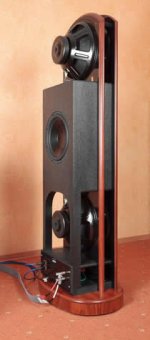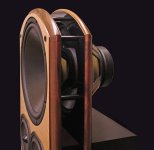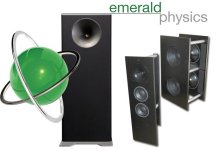But if the gap gets bigger between clamshell drivers this virtual baffle should loose its magic.
Sorta but not 100% true. It all depends on the frequency range (specifically the highest frequency) over which you intend to use the compound dipole configuration.
Let's assume a fixed listening position at 2m from the center between the two drivers. As the driver-driver separation increases, one driver is moving towards you and the other back. This causes their wavefronts to arrive at different times, the rear one arriving later. This is a phase difference, but also the front SPL will be higher than the rear because it is closer. As the separation increases the front driver is actually getting "louder" because is it getting closer to the observation point, and the rear is getting quieter. This is the same for a long H-frame, for example. That alone can change how the two wavefronts add at the observation point at low frequencies. But the phase difference is what limits the high frequency, where the relative phase starts to be more than 90 degrees and some cancellation occurs. The response will start to fall into a dip, a partial null, as frequency increases.
But if your "high frequency" is not all that high, then you can move the drivers quite far apart before you get any cancellation. So, no "magic" lost just two dipoles placed at some distance apart WRT to the listener.
Yes agree that output will be higher one driver vs two in clamshell configuration. what i want to say when separation distance is small we can view that gap as virtual baffle and output will be comparable to real baffle equivalent separation.but if the gap is high we loose energy and output will be lower if we would use real baffle instead of equivalent separation distance.put two drivers at the ends off the pipe. And then remove the pipe. SPL will change a lot. Simulating H frame we use two monopole sources separated by distance. Not dipole sources. With dipole sources output will be lower. So i see the point in clamshell only if i want small baffle to work with.
Here's your H or U frames.That's a sealed bandpass enclosure. It is none of these: open baffle, H-frame, U-frame, or clam shell.
No top makes the enclosure OPEN baffle.
If the 8 drivers were not isobaric, then the 4 driver mounting would still be clamshell.
did you really get some sound out of that trunk sub thing, without a cover?
Please, I never played it OPEN baffle.
The point is some of the PRINCIPLES discussed in this thread are in that BP4 enclosure.
People only see what they want to see.
The point is some of the PRINCIPLES discussed in this thread are in that BP4 enclosure.
People only see what they want to see.
Don't matter the context. An OPENED enclosure is an OPEN BAFFLE configuration. The 8 drivers are mounted in a clamshell configuration minus the isobaric clamshell configuration.
No magic lost even if the space is bigger. Please see commercial, and great sounding speakers like Legacy Audio Whisper.But if the gap gets bigger between clamshell drivers this virtual baffle should loose its magic. But still it is interesting if somebody needs a small baffle and don't want to do any physical baffle. Didn't try clamshells, but yes should work to some limited extent.
Attachments
Semantic issue? This set-up is almost the same as a single speaker but it has an offset between the woofers. The effective null is 90 degrees to the side caused by the wave from the back of the bottom woofer interfering with the wave from the back of the top woofer, the gap has a neutral pressure and no sound is emitted. From a system view there is no sound to nullify. Is the front chamber of an isobaric woofer a null? The pressure is constant, the pressure change measures zero and is null. This system with woofers facing each other and placed very close is almost an isobaric system.View attachment 1446837
i would add like this
The sound emitted from the woofers is nullified to the sides in the listening room, the sound in the middle is null because there is no pressure change to begin with. Also, it doesn't affect the sound from the back and front of the system. There are two phenomena causing nulls. So to be more clear on the drawing I said there was no pressure change in the space between the woofers. Null is defined as an empty value so the area between the woofers is a null because there is no pressure change, the value is 0. The null's to the side aren't really nulls because they change depending on frequencies and room effects. So cancellation, or better destructive interference is what happens at 90 degrees to the side of the system.
So, did I get it right this time? If so I'll draw it over. Words mean things, we should be accurate in what we say to limit confusion.
Are there any colorful simulations to show how the clam shell configuration is more directive than a regular di-pole?
Like these: https://www.diyaudio.com/community/...s-and-discussion-re-live-edge-dipoles.401432/
Like these: https://www.diyaudio.com/community/...s-and-discussion-re-live-edge-dipoles.401432/
Please, I never played it OPEN baffle.
The point is some of the PRINCIPLES discussed in this thread are in that BP4 enclosure.
People only see what they want to see.
No, because it is no more directive than a "regular dipole", as long as the separation distance between is small compared to the wavelength of radiation.Are there any colorful simulations to show how the clam shell configuration is more directive than a regular di-pole?
Note the polarity on the left is 180 degrees different due to the reversed polarity of the opposite sides of the dipole.
In two dimensions, the dipole polar pattern looks like a figure of 8, in three dimensions, a torus (donut) shape.
https://www.linkwitzlab.com/models.htm
The radiation pattern of a monopole speaker (a typical sealed, bass reflex or band-pass subwoofer) is spherical, a ball with radiation polarity the same at any point of it's circumference.
Multiple monopole drivers are all wired so their external output is the same polarity.
Art
The last is OMNIpole, at least at low freq.
Like I said and linked earlier, wide spectrum of wavelengths makes problems (=interferences) at high freq/short wavelength - in practical applications like loudspeakers.
Like I said and linked earlier, wide spectrum of wavelengths makes problems (=interferences) at high freq/short wavelength - in practical applications like loudspeakers.
Practical examples, from Klippel NFS scans done by Erin
A small coaxial with BR port on backside
- omnipole to 400Hz, monopole above it (exception is port resonance at 900hz)

Dipole planar 2-way
- dipole pattern constant up t0 900Hz, then scattering of interferences
- negative polarity of backside radiation is not visible here!

A small coaxial with BR port on backside
- omnipole to 400Hz, monopole above it (exception is port resonance at 900hz)
Dipole planar 2-way
- dipole pattern constant up t0 900Hz, then scattering of interferences
- negative polarity of backside radiation is not visible here!
Thank you so much for posting that! I get so tired of people making claims on hify forums with no data to back up their ideas. Yes I'm guilty too. 
I guess the next step is to show that two Magnepans placed back to back, like the Legacy Whisper. make a more directional pattern than a single dipole. I don't understand why this would be so because the null between the drivers is just that, a null. It has no output. The sum of the waves is zero. So, I think the increased directionality is due to the spacing between the front woofer and rear woofer. I think a baffle can have a similar effect but there would be diffraction effects and cavity resonances, and maybe the reduction of those are what is causing the increased clarity?

I guess the next step is to show that two Magnepans placed back to back, like the Legacy Whisper. make a more directional pattern than a single dipole. I don't understand why this would be so because the null between the drivers is just that, a null. It has no output. The sum of the waves is zero. So, I think the increased directionality is due to the spacing between the front woofer and rear woofer. I think a baffle can have a similar effect but there would be diffraction effects and cavity resonances, and maybe the reduction of those are what is causing the increased clarity?
Connecting two drivers electrically parallel to same amp will reduce inductance which leads to higher spl with same volume pot setting (voltage), compared to a single driver.
Acoustical efficiency of two drivers side by side is better than clamshell. Notice how bad is spl response of clamshell above 1kHz, because of "motor" obstructing sound and causing interferences. CS is clamshell, DS is side-by side. I used serial electric wiring!

Increasing distance of clamshell drivers makes more interferences in high freq, directivity is similar below that (constant dipole pattern)

Link to my tests https://www.diyaudio.com/community/threads/various-nude-dipole-arrangements-measured.418853/
Acoustical efficiency of two drivers side by side is better than clamshell. Notice how bad is spl response of clamshell above 1kHz, because of "motor" obstructing sound and causing interferences. CS is clamshell, DS is side-by side. I used serial electric wiring!
Increasing distance of clamshell drivers makes more interferences in high freq, directivity is similar below that (constant dipole pattern)
Link to my tests https://www.diyaudio.com/community/threads/various-nude-dipole-arrangements-measured.418853/
Last edited:
My conclusion from the tests above were
1. clamshell is waste of resources and worst possible acoustic behaviour
2. clamshell has the motor making obstructions for high freq
3. two side by side has less distortion than single. Also more spl if connected parellel electrically.
4. two side by side other reversed has even less distortion
I didn't test ripole nude system. I think it is a very bad idea. Perhaps I should prove it by tests...
1. clamshell is waste of resources and worst possible acoustic behaviour
2. clamshell has the motor making obstructions for high freq
3. two side by side has less distortion than single. Also more spl if connected parellel electrically.
4. two side by side other reversed has even less distortion
I didn't test ripole nude system. I think it is a very bad idea. Perhaps I should prove it by tests...
- Home
- Loudspeakers
- Multi-Way
- The 'Circles of Doom’... Open baffleless full range speakers



